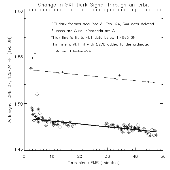
 |
Documentation > SXT Observation Notes > this page |
Image name: orbit_dark_variation.png (click image to enlarge)
Image size: 8.34600 KB (600x600)
Date submitted: 13-Jun-1994

ORBIT VARIATION OF SXT DARK SIGNAL L. Acton 10-Jun-94, corrected 13-Jun-94. This plot demonstrates the change in gross SXT dark signal through a daylight pass. The diamonds (Al.1) were taken over 3 passes during an XBP campaign when I made a mistake on the sequence table and took far too many dark frames. The crosses were AlMg dark images taken the next day with the table corrected to make fewer dark frames. SAA data at the end of each pass have been rejected--which explains why the data only extend to 50 minutes. The gap between 18 and 28 minutes is caused by BDR overwrite. All data were taken with DPE=27 (10.7 sec) exposure. I was surprised to see that the AlMg dark signal is nearly 4% larger than the Al.1 dark signal Note the sharp drop in dark signal at the beginning of each orbit day. I believe this to be due to recovery of the CCD from the morning UV flood. The remaining slow decrease of 1.2% over one hour in the dark signal is not understood at this time. Perhaps this, too, is recovery from the effects of UV flood. For this case the orbit began with sunrise over KSC and ended with sunset in the SAA. The onset of dark signal increase at the boundary of the SAA, not shown here, was quite sharp.